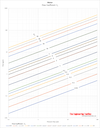Liquid, Steam and Gas - Flow Coefficients Cv
Calculate flow coefficients for the design of control valves - Imperial units.
With the flow coefficients capacities of valves at different sizes, types and manufacturers can be compared. The flow coefficients are in general determined experimentally and express the
flow capacity in imperial units - GPM (US gallons per minute) that a valve will pass for a pressure drop of 1 lb/in2 (psi)
The flow factor - Kv - is also commonly used with capacity in SI-units.
The flow coefficient - Cv - required for a specific application can be estimated by using specific formulas for the different fluids or gases. With an estimated Cv value - the correct size of control valve can be selected from the manufacturers catalogs.
Note that an oversized control valve may hurt process variability by putting too much gain in the valve leaving less flexibility for the controller. An oversized valve operates more frequently at lower openings with increased dead band as result.
Flow Coefficient - Cv - for Liquids
For liquids the flow coefficient - Cv -is expressed with water flow capacity in gallons per minute (GPM) of 60 oF with pressure drop 1 psi (lb/in2).
Flow expressed by volume
Cv = q (SG / dp)1/2 (1)
where
q = water flow (US gallons per minute)
SG = specific gravity (1 for water)
dp = pressure drop (psi)
or alternatively in metric units:
Cv = 11.6 q (SG / dp)1/2 (1b)
where
q = water flow (m3/hr)
SG = specific gravity (1 for water)
dp = pressure drop (kPa)
Water Control Valves - flow coefficient Cv diagram
Flow expressed by weight
Cv = w / (500 (dp SG)1/2) (1c)
where
w = water flow (lb/hr)
SG = specific gravity (1 for water)
dp = pressure drop (psia)
or alternatively in SI units:
Cv = 5.8 w / (500 (dp SG)1/2) (1d)
where
w = water flow (kg/hr)
SG = specific gravity (1 for water)
dp = pressure drop (kPa)
Example - Flow Coefficient Liquid
The flow coefficient for a control valve which in full open position passes 25 gallons per minute of water with a one pound per square inch pressure drop can be calculated as:
Cv = (25 gpm) (1 / (1 psi))1/2
= 25
Flow Coefficient - Cv - for Saturated Steam
Since steam and gases are compressible fluids, the formula must be altered to accommodate changes in density.
Critical (Choked) Pressure Drop
With choked flow and critical pressure drop, the outlet pressure - po - after the control valve is aprox. 58% of the inlet pressure - pi - before the control valve. The flow coefficient at choked - or critical - flow can be expressed as:
Cv = m / (1.61 pi) (2)
where
m = steam flow (lb/hr)
pi = inlet steam absolute pressure (psia)
Critical (Choked) pressure drop in metric units:
kv = m / (12 pi) (2b)
where
m = steam flow (kg/hr)
pi = inlet steam absolute pressure (bara)
Non Critical Pressure Drop
For non critical pressure drop the outlet pressure - po - after the control valve is more than 58% of the inlet pressure - pi - before the control valve. The flow coefficient for non critical flow can be expressed as:
Cv = m / (2.1 ((pi + po) dp)1/2) (2c)
where
po = outlet steam absolute pressure (psia)
Flow Coefficient - Cv - Super-heated Steam
The flow coefficient for superheated steam should be multiplied with a correction factor:
Cv = Cv_saturated (1 + 0.00065 dt) (3)
where
dt = steam temperature above saturation temperature at the actual pressure (oF)
Example - flow coefficient super-heated steam
The flow coefficient for steam super-heated with 50 oF can be calculated as:
Cv = Cv_saturated (1 + 0.00065 (50 oF)
=1.0325 Cv_saturated
Flow Coefficient - Cv - Saturated Wet Steam
Saturated wet steam includes non evaporated water particles reducing the "steam quality" and a flow coefficient for very wet saturated steam should be multiplied with a correction factor:
Cv = Cv_saturated ζ1/2 (4)
where
ζ = dryness fraction
Example - Flow Coefficient Wet Saturated Steam
For steam with moisture content 5% the dryness fraction can be calculated as:
ζ = ws / (ww + ws)
= 0.95 / (0.95 + 0.05)
= 0.95
where
ww = mass of water
ws = mass of steam
The flow coefficient can be calculated as:
Cv = Cv_saturated (0.95)1/2
= 0.97 Cv_saturated
Flow Coefficient - Cv - Air and other Gases
Note! - there is a difference between critical and non critical pressure drops.
Critical pressure drop is approximately 47% of inlet pi absolute pressure. With critical pressure drop the outlet absolute pressure po is approximately 53% of inlet pi pressure.
Pressure Drop Larger than Critical Pressure Drop
For pressure drop larger than the critical pressure drop the flow is choked. The flow coefficient can be calculated as:
Cv = q (SG (T + 460))1/2 / (FL 834) pi (5)
where
q = free gas per hour, standard cubic feet per hour (Cu.ft/h)
SG = upstream specific gravity of flowing gas gas relative to air (SG = 1.0) at 14.7 psia and 60 oF
T = flowing air or gas temperature (oF)
FL = pressure recovery factor
pi = inlet gas absolute pressure (psia)
Pressure Drop Less than Critical Pressure Drop
For pressure drop less than the critical pressure drop the flow is not choked. The flow coefficient can be calculated as:
Cv = q (SG (T + 460))1/2 / (1360 (dp po)1/2) (5b)
where
dp = (pi - po)
po = outlet gas absolute pressure (psia)




